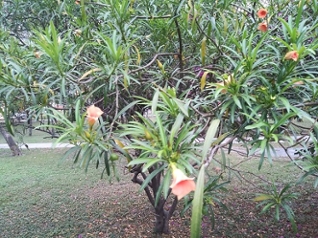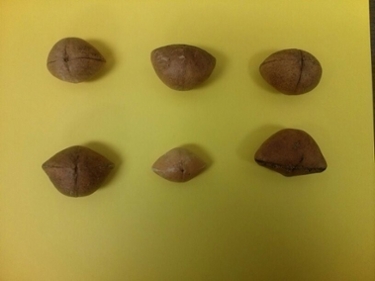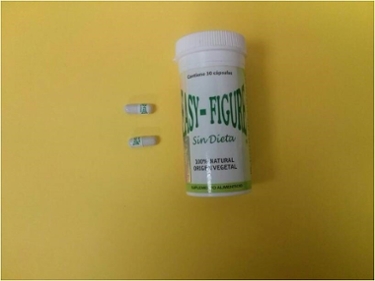
MinerAlert

MinerAlert
Thevetia spp. (Syn. Cascabela spp)
Be-still tree, Lucky nut (White, 2003).
Codo de Fraile, Cojón de gato, Hueso de fraile, Yóyotl, Yoyotli (Náhuatl)
*In Mexico, this seed may also be sold by the erroneous name of “semilla de Brasil”.

Various species of this ornamental shrub or small tree are native to southern Mexico and various other countries of Tropical America. The plants are now distributed worldwide in tropical areas, including parts of Australia, Africa, and Asia (especially in southern India and Sri Lanka).
The leaves, seeds and milky latex (‘juice”) from the stem and leaves. The bark of the tree is sometimes used. However, it should be noted that all parts of the plant, including the flowers, are poisonous.

Photo: Dr. Armando González-Stuart
Thevetia spp. flower
The latex (milky juice), the crushed seeds, and the bark are used externally as pastes or poultices.
Certain vendors and internet sites falsely promote taking small amounts of the crude seed or capsules containing the pulverized material, as a purported “natural weight loss” supplement, even though the seed has long been known to be toxic.

Photo: Dr. Armando González-Stuart
Yellow oleander fruit containing seeds

Photo: Dr. Armando González-Stuart
Yellow oleander seeds sold as capsules
Safety/Precautions:
Before you decide to take any medicinal herb or herbal supplement, be sure to consult with your health care professional first. Avoid self-diagnosis and self-medication: Always be on the safe side!
Note: For more in depth information about this plant and references, please go to the Scientific Monographs section of this site.
Argueta, A. (Editor). Plantas Medicinales de Uso Tradicional en la Ciudad de México. Mexico City: UNAM; 2014; pp. 122-123.
Frohne D, Pfander H. Poisonous Plants 2nd ed. Portland OR: Timber Press; 2005.
Mabberley D J. Mabberley’s Plant Book 4th ed. London: Cambridge University Press; 2017; pp. 28, 919.
Martínez M. Las Plantas Medicinales de México. Mexico City: Editorial Botas; 1989.
Mendoza-Castelan G, Lugo-Perez R. Plantas Medicinales en los Mercados de México. Chapingo: Universidad Autónoma Chapingo; 2011; p. 318.
Pirasath S, Arulnithy K. Yellow oleander poisoning in eastern province: an analysis of admission and outcome. Indian J Med Sci. 2013; 67(7-8):178-83. doi: 10.4103/0019-5359.125879.
Quattrocchi, U. World Dictionary of Medicinal and Poisonous Plants (4 vols.). Boca Raton, FL: CRC Press; 2012; pp. 560-561.
Rajapakse S. Management of yellow oleander poisoning. Clin Toxicol (Phila). 2009; 47(3):206-12. doi: 10.1080/15563650902824001.
Wagstaff J. International Poisonous Plant Checklist: An Evidence-Based Reference. CRC Press: Boca Raton, FL; 2008.
White R. Elsevier’s Dictionary of Plant Names of North America Including Mexico. Amsterdam: Elsevier; 2003; p. 193.
Zamani J, Aslani A. Cardiac findings in acute yellow oleander poisoning. J Cardiovasc Dis Res. 2010; 1(1):27-8. doi: 10.4103/0975-3583.59982.